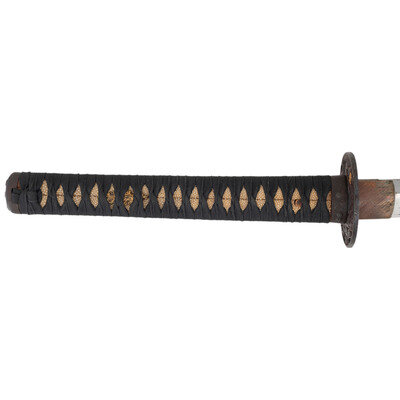An Interesting Edo-Period Japanese Katana with 39-Character Tameshi Giri (Cutting Test) Mei
Sale 1353 - Arms, Armor and Militaria
May 1, 2024
10:00AM ET
Live / Cincinnati
Estimate
$1,200 -
$1,800
Sold for $6,600
Sold prices are inclusive of Buyer’s Premium
Lot Description
An Interesting Edo-Period Japanese Katana with 39-Character Tameshi Giri (Cutting Test) Mei
29" nagasa. 44" overall with tsuka and saya. Large shinogi-zukuri katana with a single hole nakago that has 39-character mei engraved and rubbed with what appears to be chalk (29 characters to right side and 10 characters to left side). The large amount of mei on both sides of the nakago could possibly be tameshi giri mei that documents the results of the blade cutting test, tester's name, date of test, date sword was made, swordsmith, and who the sword was made for. It also has an iron tsuba that is ornately chiseled depicting a water dragon with gold eyes and tails to both sides. Tsuba is also signed with 12-character mei around nakago ana (6 characters to both sides). Blade features a mosame hada, sugu hamon, ihori mune, O-kissaki, and what appears to be yakizume boshi. Mountings include iron fuchi and kashira with silver chrysanthemum details, white same, black ito, matching gold dragon menukis, and a leather wrapped saya with single hanger. Other mountings include copper habaki with koshi-yujo style file marks, and brass seppa that both appear to be signed to inside faces.
Some possible loose translations of the mei suggest that it may have been made in the Mutsu province sometime around 1801-1804. Tameshi giri was possibly conducted on the 2nd day of the 3rd month of whatever year the sword was made, and was finished for the sword recipient on the 17th day of the 12th month of that same year. Other possible translations of the mei include Fujiwara and Minamoto. There are 18 characters that have yet to be translated.
Tameshi giri (test cut) was a common practice used by samurai and swordsmiths to test the quality of their blades during the Edo period (1600-1868). Often times a samurai would test his own sword, or a renowned samurai would be chosen by the daimyo if a number of swords meant for the lord's troops were to be tested. The test loosely measured how effective a blade's cutting edge was, and was measured by the amount of bodies or body parts sliced through with a single blow. These tests were often carried out on war prisoners, prisoners sentenced to death, and even on random passersby/drifters (known as tsugi giri, or "slicing at crossroads").
Some possible loose translations of the mei suggest that it may have been made in the Mutsu province sometime around 1801-1804. Tameshi giri was possibly conducted on the 2nd day of the 3rd month of whatever year the sword was made, and was finished for the sword recipient on the 17th day of the 12th month of that same year. Other possible translations of the mei include Fujiwara and Minamoto. There are 18 characters that have yet to be translated.
Tameshi giri (test cut) was a common practice used by samurai and swordsmiths to test the quality of their blades during the Edo period (1600-1868). Often times a samurai would test his own sword, or a renowned samurai would be chosen by the daimyo if a number of swords meant for the lord's troops were to be tested. The test loosely measured how effective a blade's cutting edge was, and was measured by the amount of bodies or body parts sliced through with a single blow. These tests were often carried out on war prisoners, prisoners sentenced to death, and even on random passersby/drifters (known as tsugi giri, or "slicing at crossroads").
This lot is located in Cincinnati.
Condition Report
Good. Blade shows light scratches overall most likely from improper polishing, as well as scattered small clusters of pitting, grain openings, and small bites along edge of blade. Mountings are all in about good condition as well, mekugi peg may be too small. Leather saya shows scratching, losses, and discoloration to thread
The physical condition of lots in our auctions can vary due to
age, normal wear and tear, previous damage, and
restoration/repair. All lots are sold "AS IS," in the condition
they are in at the time of the auction, and we and the seller make
no representation or warranty and assume no liability of any kind
as to a lot's condition. Any reference to condition in a catalogue
description or a condition report shall not amount to a full
accounting of condition. Condition reports prepared by Hindman
staff are provided as a convenience and may be requested from the
Department prior to bidding.
The absence of a posted condition report on the Hindman website or
in our catalogues should not be interpreted as commentary on an
item's condition. Prospective buyers are responsible for
inspecting a lot or sending their agent or conservator to inspect
the lot on their behalf, and for ensuring that they have
requested, received and understood any condition report provided
by Hindman.
Please email armsarmor@hindmanauctions.com for any additional information or questions you may have regarding this lot.































